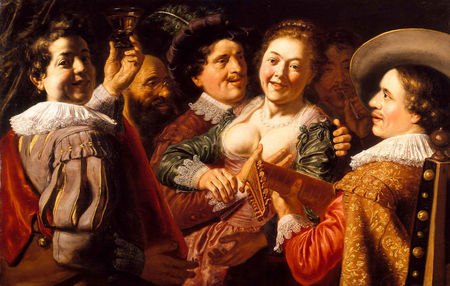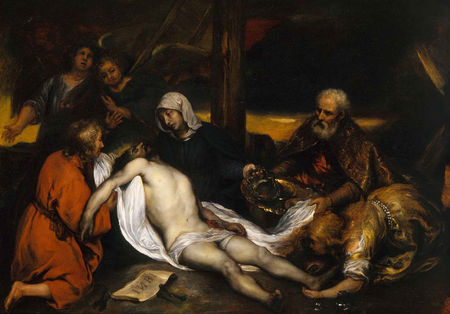"Jan Lievens: A Dutch Master Rediscovered" @ the National Gallery of Art, Washington
Jan Lievens (Dutch, 1607 - 1674), Allegory of the Five Senses, c. 1622 oil on panel 78.2 x 124.4 cm (30 13/16 x 49 in.) Private collection
WASHINGTON, DC.- The life and career of Jan Lievens (1607–1674), one of the greatest yet most enigmatic Dutch painters of the 17th century, is finally brought to light in the exhibition Jan Lievens: A Dutch Master Rediscovered, on view at the National Gallery of Art in the West Building from October 26, 2008, through January 11, 2009.
"History has not been kind to Jan Lievens, and this intriguing exhibition invites a serious reconsideration of his place in the annals of art history," said Earl A. Powell III, director of the National Gallery of Art. "The Gallery is grateful for the outstanding loans from private and public collections in Europe and America, and we hope that general visitors and scholars alike will find this show to be an eye-opener."
This exhibition and its accompanying catalogue will present an overview of the full range of Lievens' career. More than 130 of the artist's finest works will be presented, including 54 paintings, 39 drawings, and 39 prints.
Lievens was a child prodigy, whose early works in Leiden were highly praised by his contemporaries and valued by princely patrons. His later career was marked by important civic and private commissions in Amsterdam, The Hague, and Berlin. Nevertheless, his name today barely registers in the public consciousness. This exhibition and catalogue suggest that his posthumous reputation waned after many of his works were mistakenly attributed to other masters—especially Rembrandt van Rijn (1606–1669), with whom he had a somewhat symbiotic relationship—and because he worked in a remarkable range of styles, reflecting multiple influences from the various cities in which he lived.
The exhibition, arranged chronologically, includes such noteworthy paintings as Lievens' youthful and penetrating Self-Portrait (c. 1629–1630); The Feast of Esther (c. 1625), which demonstrates his connection to the Utrecht Carravaggisti; Bearded Man with a Beret (c. 1630), an expressive character study of the type Lievens made during his Leiden period; Job in His Misery (1631), one of his finest and most important works; Prince Charles Louis with His Tutor, as the Young Alexander Instructed by Aristotle (1631), painted for the king and queen of Bohemia; The Lamentation of Christ (c. 1640), an Antwerp period altarpiece that reflects the influence of Anthony van Dyck; and Brinio Raised on a Shield (1660), an oil sketch/modello of an important commission for the Amsterdam Town Hall, now called the Royal Palace.
Among the works on paper are The Raising of Lazarus (1630-1631), an etching Lievens made after a painting of the same subject (also in the exhibition), and Village Street with a Windmill (c. 1650s), one of a number of Lievens' landscape drawings from his Amsterdam period.
Lievens and Rembrandt
Lievens and Rembrandt were born in Leiden just over a year apart, studied with the same master, Pieter Lastman (1583–1633), and lived near one another until about 1632. Many parallels exist between the works that each produced in Leiden in the 1620s and early 1630s. Even though Lievens' career began before Rembrandt's, he was often wrongly described as a follower or student of the latter. It is proposed in this exhibition and catalogue that, in many respects, Lievens was the initiator of the stylistic and thematic developments that characterized both artists' work in the late 1620s.
Lievens' late work has been consistently neglected, partially because earlier historians believe that he lost his way after leaving Rembrandt's orbit, and succumbed to the countervailing influence of the great Flemish master Anthony van Dyck (1599–1641) upon his move to London in 1632 in search of courtly success. In fact, after he moved to Antwerp in 1635, where he thoroughly adapted the prevailing taste for Flemish modes of painting, Lievens achieved the international renown he so desperately sought. After his return to the Netherlands, he received important commissions in Amsterdam, The Hague, and Berlin.
Among the reasons Lievens' later years have been overlooked was that his frequent moves kept him from fitting into historical assessments of the period, which generally focus on the stylistic character of the time. Finally, there are critical gaps in our knowledge of his art, as many of his most important documented works are lost, and those large-scale commissions that survived are all but inaccessible to most visitors. Consequently, it is challenging to reconstruct the evolution of his painting style and the radical decisions he made over the course of his career. It was not until the mid–20th century that Lievens' body of work began to be reassessed and a number of important works, wrongly attributed to Rembrandt and other artists, were recognized as being by his hand. Many of these paintings, as well as some recent discoveries, will be in the exhibition.
The exhibition is organized by Arthur Wheelock, curator of northern baroque painting at the National Gallery of Art, in conjunction with Laurie Winters, curator of earlier European art at the Milwaukee Art Museum; Bob van den Boogert and Jaap van der Veen from the Rembrandthuis; and Lloyd DeWitt, assistant curator of European paintings before 1900 at the Philadelphia Museum of Art. Wheelock made the final selection of works of art, in close consultation with Stephanie Dickey from Queen's University, Kingston, Ontario, for the prints; and Gregory Rubinstein, head of old master drawings at Sotheby's London, for the drawings.
Jan Lievens (Dutch, 1607 - 1674), The Lamentation of Christ (modello), c. 1640 oil on panel 39 x 54 cm (15 3/8 x 21 1/4 in.) Charles Roelofsz, Amsterdam

/https%3A%2F%2Fprofilepics.canalblog.com%2Fprofilepics%2F1%2F0%2F100183.jpg)
/https%3A%2F%2Fstorage.canalblog.com%2F03%2F02%2F119589%2F96711876_o.jpg)
/https%3A%2F%2Fstorage.canalblog.com%2F11%2F31%2F119589%2F94773502_o.jpg)
/https%3A%2F%2Fstorage.canalblog.com%2F20%2F83%2F119589%2F94772815_o.jpg)
/https%3A%2F%2Fstorage.canalblog.com%2F26%2F72%2F119589%2F75604929_o.jpg)
/https%3A%2F%2Fstorage.canalblog.com%2F59%2F60%2F119589%2F26458628_o.jpg)




/http%3A%2F%2Fstorage.canalblog.com%2F83%2F81%2F119589%2F122164285_o.jpg)
/http%3A%2F%2Fstorage.canalblog.com%2F74%2F87%2F119589%2F34859783_o.jpg)
/http%3A%2F%2Fstorage.canalblog.com%2F28%2F52%2F119589%2F34858633_o.jpg)
/http%3A%2F%2Fstorage.canalblog.com%2F59%2F70%2F119589%2F30117295_o.jpg)